

UN conference on nuclear proliferation a big test for Obama. Can President Obama bring "sexy" back to nuclear non-proliferation?
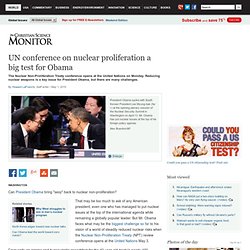
Skip to next paragraph Subscribe Today to the Monitor Click Here for your FREE 30 DAYS ofThe Christian Science MonitorWeekly Digital Edition That may be too much to ask of any American president, even one who has managed to put nuclear issues at the top of the international agenda while remaining a globally popular leader. But Mr. Grappling With Nuclear Asia. The latest NPT review had interesting implications for Asia’s nuclear security.
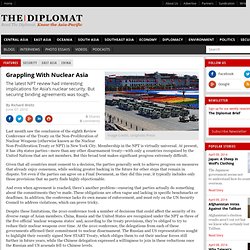
But securing binding agreements was tough. Last month saw the conclusion of the eighth Review Conference of the Treaty on the Non-Proliferation of Nuclear Weapons (otherwise known as the Nuclear Non-Proliferation Treaty or NPT) in New York City. Membership in the NPT is virtually universal. At present, it has 189 states parties—more than any other disarmament treaty—with only 4 countries recognized by the United Nations that are not members. But this broad tent makes significant progress extremely difficult. Given that all countries must consent to a decision, the parties generally seek to achieve progress on measures that already enjoy consensus, while seeking greater backing in the future for other steps that remain in dispute. And even when agreement is reached, there’s another problem—ensuring that parties actually do something about the commitments they’ve made. START debate: 3 things nuclear arms treaty would do, 3 things it won't - DOES further reduce strategic nuclear arsenals of both counties.
Who has nukes? - The Christian Science Monitor. More galleries Image 1/10: UNITED STATES: The US was the world’s first country to develop the nuclear bomb, in the early 1940s, and is the only country to ever use it offensively, during World War II.

The US has 2,700 deployed nukes, plus another 2,500 to 3,500 nukes on reserve, according to the International Commission on Nuclear Non-proliferation and Disarmament. Nobelprize.org. Treaty on the Non-Proliferation of Nuclear Weapons. The Treaty on the Non-Proliferation of Nuclear Weapons, commonly known as the Non-Proliferation Treaty or NPT, is an international treaty whose objective is to prevent the spread of nuclear weapons and weapons technology, to promote cooperation in the peaceful uses of nuclear energy and to further the goal of achieving nuclear disarmament and general and complete disarmament.[1] Opened for signature in 1968, the Treaty entered into force in 1970.
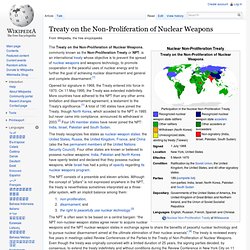
On 11 May 1995, the Treaty was extended indefinitely. More countries have adhered to the NPT than any other arms limitation and disarmament agreement, a testament to the Treaty's significance.[1] A total of 190 states have joined the Treaty, though North Korea, which acceded to the NPT in 1985 but never came into compliance, announced its withdrawal in 2003.[2] Four UN member states have never joined the NPT: India, Israel, Pakistan and South Sudan. The NPT consists of a preamble and eleven articles. Treaty "pillars"[edit] Key articles[edit] 2. Nuclear proliferation. World map with nuclear weapons development status represented by color.
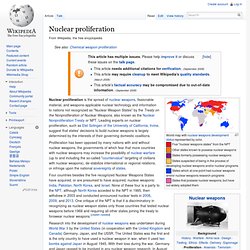
Five "nuclear weapons states" from the NPT. Facts For Working People: North Korea "destabilizing" east Asia with its nuclear industry, says US. It would be a perfect world if only the US and Israel had nuclear weapons. The US is up in arms about North Korea’s nuclear activity.
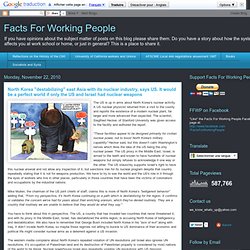
A US nuclear physicist returned from a visit to the county and reports the existence of a modern nuclear plant, far larger and more advanced than expected. Nuclear Proliferation: An Imposing Issue. Grounds for a new security paradigm have emerged from an international conference tackling the problem of nuclear terrorism.
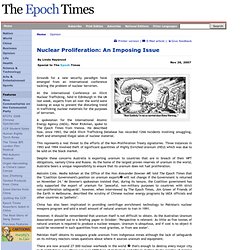
At the International Conference on Illicit Nuclear Trafficking, held in Edinburgh in the UK last week, experts from all over the world were looking at ways to prevent the disturbing trend in trafficking nuclear materials for the purposes of terrorism. A spokesman for the International Atomic Energy Agency (IAEA), Peter Rickman, spoke to The Epoch Times from Vienna. He described how, since 1993, the IAEA Illicit Trafficking Database has recorded 1266 incidents involving smuggling, theft and attempted illegal sales of nuclear material. This represents a real threat to the efforts of the Non-Proliferation Treaty signatories. Three instances in 1993 and 1994 involved theft of significant quantities of Highly Enriched Uranium (HEU) which was due to be sold on the black market. However, it should be remembered that uranium itself is not difficult to obtain. Egyptian revolution and nuclear proliferation…
When the Iranian Revolution overthrew the Shah in 1979, years of “peaceful” U.S. nuclear cooperation with the Persian dictator suddenly seemed like they had been a bad idea.

In part as a result of this early assistance, Tehran is on the road to producing a bomb’s worth of weapons-grade uranium in roughly a year or less. And with protests upending governments in Egypt, Tunisia, and the rest of the Middle East, this sequence is on the cusp of repeating itself to produce a nuclear domino effect. Yet, remarkably—given its stated commitment to denuclearization—the Obama administration seems eager to pursue policies that will only make the threat worse.
International Atomic Energy Agency (IAEA) Infcirc140.pdf (application/pdf Object) Nuclear Weapons From Grolier’s The New Book of Knowledge. Nuclear Chemistry: Nuclear Proliferation. By Dr.
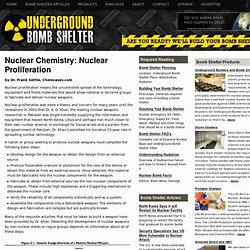
Frank Settle, Chemcases.com Nuclear proliferation means the uncontrolled spread of the technology, equipment and fissile materials that would allow national or terrorist groups to fabricate and deliver nuclear weapons. Nuclear proliferation was more a theory and concern for many years until the revelations in 2003 that Dr. A. Q. Nuclear weapons: how many are there in 2009 and who has them? Are we headed for a nuclear-free world?
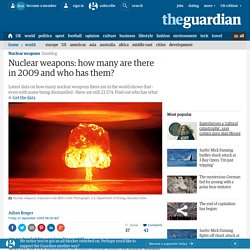
News that the US is abandoning the missile defense system has brought renewed attention to the issue of nuclear proliferation. The thing is, counting nuclear weapons is a bit like counting votes – a lot depends on who is doing the counting, and how. The disarmament treaty currently being negotiated between the US and Russia applies to deployed strategic warheads, along with their delivery systems, but that leaves out most of the weapons both countries are sitting on. Key Issues: Nuclear Weapons: Issues: Effects on Health & Enviornment: Physical Health: Compensation.
Overview Nearly 40 years after the first of its 210 nuclear tests, France is preparing to compensate people affected by the fallout. The move leaves the UK isolated in its policy of rejecting liability for illnesses suffered by test participants, reports Aidan Lewis.Early in the morning of 13 February, 1960, several thousand French servicemen gathered in the Algerian Sahara to witness "Gerboise Bleue" or "Blue Desert Rat", an atmospheric nuclear explosion four times more powerful than the bomb dropped on Hiroshima.
This was the moment France obtained its nuclear deterrent, to the great joy of the president of the time, Charles de Gaulle. But the test programme it launched also exposed participants and local populations to potentially lethal radiation. Both groups claim that they have been plagued by health problems, from aggressive cancers to minor cardio-vascular complaints. Slow progress. Remarks By President Barack Obama In Prague As Delivered. Office of the Press Secretary ___________________________________________________________________ FOR IMMEDIATE RELEASE April 5, 2009 REMARKS BY PRESIDENT BARACK OBAMA Hradcany Square Prague, Czech Republic 10:21 A.M. (Local) PRESIDENT OBAMA: Thank you so much. The Futurist: Nuclear Deal Signed with India, American Diplomat Killed in Pakistan.
President Bush's critical visits to India and Pakistan were bound to be anything but dull, and two events have occured in the last 12 hours that signify not only the diverging brand images of both India and Pakistan, but also how many issues of global importance converge on this region. India and the US have signed a nuclear energy agreement. This not only helps world oil prices by easing India's demand for oil, it is essentially a stamp of approval for India as a responsible, democratic chaperone of nuclear weapons. This cartoon from Cox and Forkum says it all. Things are not so rosy over in Pakistan. A US diplomat was killed by an Al-Qaeda suicide bomber, an attack strategically planned to complicate Bush's visit there later this week.
India Tests Agni-V Long Range Nuclear Capable. India on Thursday tested a new long-range missile capable of delivering a one-tonne nuclear warhead anywhere in regional military rival China, a defence source said. The 17-metre (56-foot) Agni V, with a range of more than 5,000 kilometres (3,100 miles), was launched at 8:05 (0235 GMT) from a test site off the eastern state of Orissa, said an official at the site who declined to be identified. “It will take some time to know whether it has been successful,” the official added.
India views the 50-tonne Agni V as a major boost to its regional power aspirations and one that narrows – albeit slightly – the huge gap with China’s technologically advanced missile systems. A successful test would leave India knocking at the door of a select club of nations with inter-continental ballistic missiles (ICBMs) with ranges of up to 8,000km. Currently only the five permanent members of the UN Security Council – Britain, China, France, Russia and the United States – possess a declared ICBM capability. Nuclear Doctrine of Pakistan: Dilemmas of Small Nuclear Force in the Second Atomic Age. Israel’s nuclear, biological and chemical weapons. Stephen LendmanIsrael’s long known open secret is its formidable nuclear arsenal. Less is known about its chemical and biological weapons (CBW) capability.
More on that below.In 1986, Dimona nuclear technician Mordechai Vanunu revealed documents showing what many long suspected. Israel had been secretly developing, producing and stockpiling nuclear weapons for years. Experts called his information genuine. 22.04.04: The release of Mordechai Vanunu. Nuclear Non-Proliferation, Trade and Security: Department of Foreign Affairs and Trade. All of Australia's uranium is exported for exclusively peaceful purposes, and only to countries and parties with which Australia has a bilateral nuclear cooperation (safeguards) Agreement. These Agreements ensure that Australia's nuclear exports remain in exclusively peaceful use, and may only be retransferred to a party with a bilateral cooperation Agreement with Australia. Australia's network of bilateral safeguards Agreements complements and builds upon the IAEA's safeguards regime. Monte Bello Island Safari.
"We have made a successful start. Abdul Qadeer Khan - Allvoices. Abdul Qadeer Khan. Abdul Qadeer Khan,[note 1] NI, HI, FPAS Abdul Qadeer Khan was one of Pakistan's top scientists,[3] and was involved in the country's various scientific programs until his dismissal.[3] In January 2004, Khan was officially summoned for a debriefing on his suspicious activities in other countries after the United States provided evidence to the Pakistan Government, and confessed it a month later.[3] Some have alleged that these activities were sanctioned by the authorities, though the Pakistan government sharply dismissed the claims.[4][5] After years of nominal house arrest, the Islamabad High Court (IHC) on 6 February 2009 declared Abdul Qadeer Khan to be a free citizen of Pakistan, allowing him free movement inside the country.
Early life[edit] THE TERRORLAND: Militarization & Talibanization leave over 82 percent Pakistanis in poverty. * Be brave, rise for you rights—coward tyrants breath their last in the Animal Farm! 20 rare images of Chinese nuclear test during Sixties.